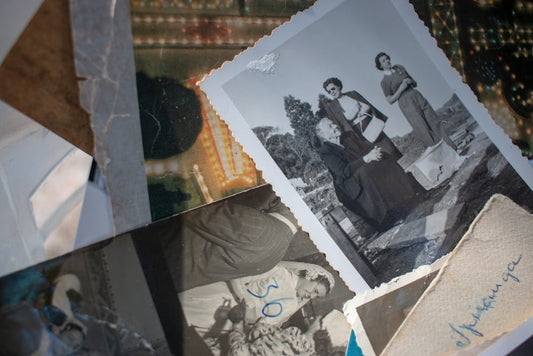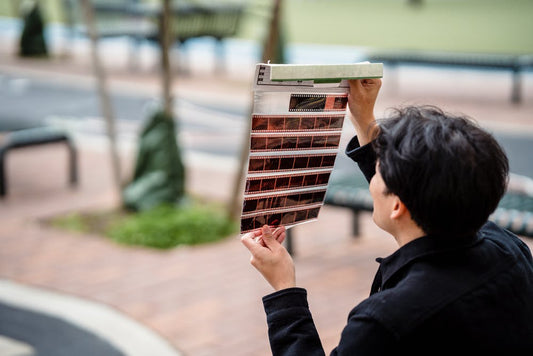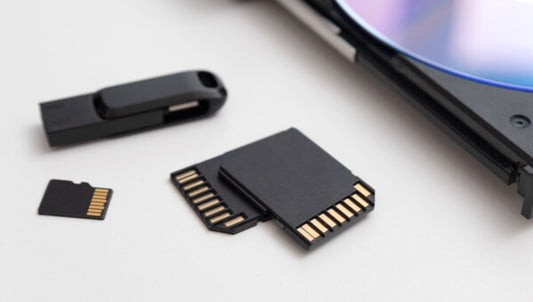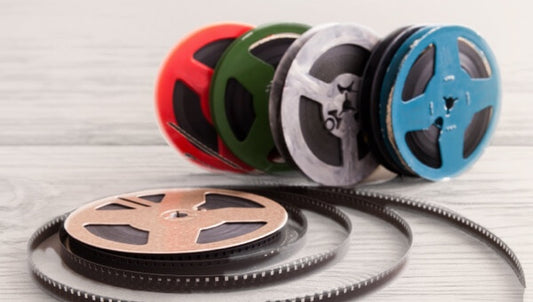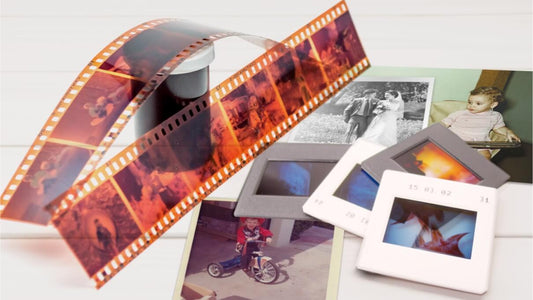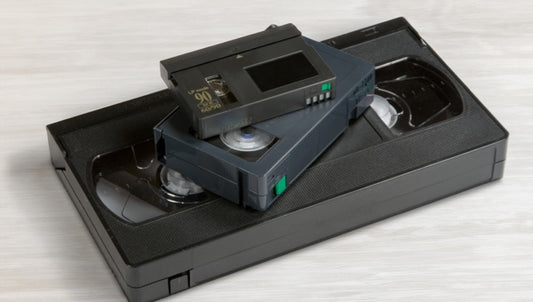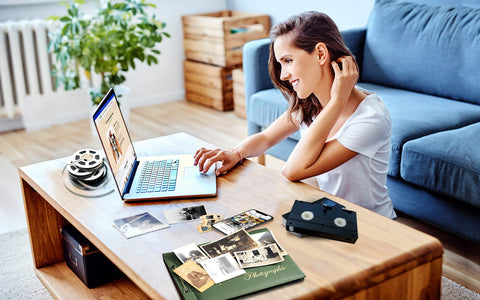Today, most of us have a digital camera in our pocket and we can capture, share, and edit memories directly on our smartphone, but it wasn’t long ago when the digital camera was a new, popular, trendy technology.
While the concept of the digital camera began over 60 years ago, the history of the digital camera includes rapid improvements in resolution and technology that developed into what we know today. Capture archival experts put together the history of the first digital camera and beyond to demonstrate the progression of technology.
Keep reading to learn how the idea of the digital camera began, when were cameras invented that captured digital images, and what advancements were made in the 90s and 2000s.
Quick Overview of The History of the First Digital Camera
- The Concept of Digital Cameras
- The First Digital Camera
- Evolution of Digital Cameras
- Impact of the First Digital Camera
- Future of Digital Cameras
The Concept of Digital Cameras

The concept of digital photography began long before the technology was available to capture digital images. In the early 1960s, a man named Eugene F. Lally who worked in the NASA Jet Propulsion Laboratory had the idea to capture digital images using a mosaic photosensor.
His idea was to develop new technology that could take pictures of the planets and stars while traveling through space. This would provide relevant information about the astronauts’ locations. While this concept would take over a decade to contribute to any real prototypes, Lally did figure out how to remove red eye in analog photos.
Then, in the early 1970s, Texas Instruments employee Willis Adcock patented the idea for a filmless camera. Around the same time in 1972, the Landsat 1 satellite would start using the multispectral scanner (MSS) to take digital images of the Earth. For 6 years, this satellite would transmit over 300,000 digital photographs of the planet and orbit 14 times every day.
Over the next few years, other attempts at an all-digital camera were proposed, but ultimately failed. This included the Cromemco Cyclops which was introduced in 1975 and published in Popular Electronics magazine. That same year came what is generally known as the first digital camera.
The First Digital Camera
The world’s first digital camera was developed in 1975 by Eastman Kodak engineer Steven Sasson in Rochester, New York. It didn’t resemble the DSLR camera systems we are used to, weighed almost 4 kilograms, and was roughly the size of a toaster. While it could only capture black-and-white images onto a digital cassette tape, it revolutionized digital photography with several new technologies.
To build this prototype, Steve Sasson used a movie camera lens, Motorola parts, 16 batteries, and charge-coupled device (CCD) sensors originally developed by Fairchild Semiconductor, RCA, and Texas Instruments.
While today’s camera phones offer 12-megapixels, or 12 million pixels in a single digital image, the original Kodak digital camera offered .01 megapixels. After a year of working on the cameras, Sasson took the first photo in December of 1975 of Kodak lab technician, Joy Marshall. While it only took around 50 milliseconds to capture the image, it took 23 seconds to record the first digital photo to tape.
To use the camera, the photographer would flip a switch to turn it on and then flip it a second time to take the photo. The CCD would capture the image and run it through an analog to digital converter to be stored temporarily on a computer chip. Then, the image was transferred to a cassette.
To view the images, Sasson and his coworkers invented a special playback device that converted standard NTSC signals into images that could be displayed on a television screen. Compared to modern Apple iPhones, digital SLR cameras, and high-end digital photography, the first digital camera seems archaic with poor image quality and complicated technology.
Sasson continued to work on the camera to improve it and was granted a patent for the camera in 1978, but the prototype was never put into production. Kodak didn’t see a market for digital cameras and, instead, continued to focus on film photography.
Evolution of Digital Cameras

By the early 1980s, many companies like Fujifilm and Sony were working on digital camera technology including LCD viewfinders and innovative image sensors. In 1981, Sony unveiled a prototype Mavica Magnetic Video Camera model, the first SLR camera (single lens reflex) that was publicly demonstrated.
While not technically a digital camera, the Sony Mavica was an analog electronic camera that acted as a bridge between traditional film photography and digital photography. Basically, the Mavica stored analog pictures on digital floppy disks called Mavipaks that could hold up to 50 color photos. The light sensitivity of the sensor was ISO 200 with a fixed shutter speed of 1/60 second.
In 1986, Canon used similar technology to unleash the first SVF and the first electronic SLR camera to be sold in the United States, the Canon RC-701. This marvelous camera used an SLR viewfinder, CCD sensor, and interchangeable lenses.
In the next few years, both Japan and U.S.-based companies worked toward releasing the first digital camera widely available to consumers. In 1988, Fujifilm introduced the FUJIX DS-1P, the first fully digital camera that recorded digital images using a semiconductor memory card.
Then, the first consumer digital camera sold in the U.S. was the 1990 Dycam Model 1. This camera looks closer to the digital camera models we are used to could digitally store JPEG and MPEG pictures and connect directly to a computer for download.
This led to the first commercially available DSLR camera, the Kodak DCS-100 and soon more companies were jumping on the digital camera trend, including Apple who launched Apple QuickTake 100 in 1994. This was the first color digital camera that cost less than $1,000, which made it possible for more Americans to start capturing precious memories in digital format.
Over the next few years, the Casio QV-10 added an LCD screen and pivoting lens, Logitech debuted the first webcam, Kyocera released the first camera phone, Nikon developed mirrorless cameras, and the Ricoh RDC-1 added video capability to point-and-shoot solid state cameras.
In the early 2000s and into the 2010s and beyond, APS lenses and CMOS sensors improved the resolution, reduced the battery requirements, and made it possible to condense digital cameras to easily fit into cell phones.
Impact of the First Digital Camera

While it took over a decade from the first digital camera to commercially available options, the first digital camera had a profound impact on film cameras and the photography industry as a whole. The CCD technology and the idea to store digital images with the first digital camera influenced all future digital camera technologies which influence our daily life and experiences.
Due to the convenience, quality, and ability to instantly see the photo on an LCD screen, digital cameras have largely replaced film cameras. In addition, with digital cameras, you can take as many photos as you want instead of relying on film. You can take and delete bad pictures in an instant, which means people could capture more memories without worry. This also made it much more affordable to use a digital camera than it was to use a film camera.
Digital cameras also made it possible to compact an entire camera into a smartphone and allowed us all to carry a camera around in our pockets. Additionally, instead of having physical photos that take up space, we can store digital images on the Cloud, memory cards, and hard drives and share them easily across the world over social media and email.
Future of Digital Cameras

While we can only guess what will happen to digital cameras 50 years from now, there are some interesting predictions. Digital cameras can become even smaller and still produce higher quality images, but some other possible innovations may not seem so obvious.
Battery power will also get better and instead of having to plug in your phone or camera every day, you may never have to charge them. In fact, some experts believe that digital cameras of the future could implement solar technology for unlimited battery power.
Furthermore, future digital cameras may be able to stimulate the smell of a memory. The MIT Media Lab proposed the idea of smellography, or smell cameras, that use a pump connected to a smartphone. This would capture smells in a gelatin capsule that would play with the video or photographic memory later.
Finally, digital cameras of the future may use AI technology to improve the entire process of picture taking. Artificial intelligence could create new gateways for artistic expression and storytelling through digital images.
As you can see, Steve Sasson, who invented the first digital camera, unleashed an entire timeline of impactful technologies that impact both professional photography and our daily lives and it appears that it will continue to do so for the foreseeable future.
Conclusion

The concept of the first digital camera has been around since the 1960s, but if you were wondering, “when was the first digital camera made?”, then the answer was 1975. Since then, digital camera technology has incorporated a long list of inventions by multiple companies like Sony, Nikon, and Canon. Now, we can fit a high-resolution digital camera into our pocket and share digital images across the world in a split second.
However, many families still have boxes and albums full of physical photos that are susceptible to fading, water damage, and other problems. That’s why it’s so important to convert photos to digital images to preserve the memories for future generations. Click here to learn about Capture photo scanning services!


